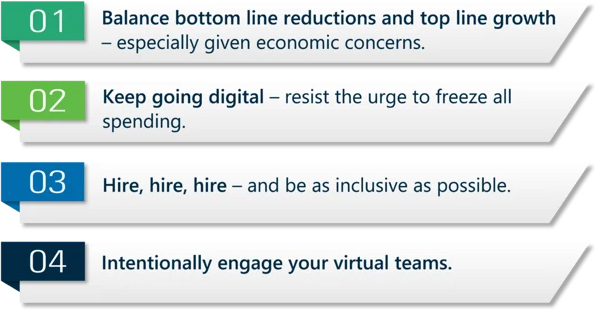
By Claire Rutkowski, Chief Innovation
For many of us, the new business year is a time to reflect on what went well, review what could have gone better, make resolutions, and set goals. If you are an architecture, engineering, or construction (AEC) firm, I suspect the past few years have been unpredictable to say the least. 2023 promises more uncertainty, driven largely by continued conflicts, a looming recession, and economic volatility.
In January I participated in a podcast called “The Critical Path,” hosted by Engineering News-Record (ENR) and discussed what resolutions AEC CEOs should be making for 2023. You can watch the full conversation here (or listen to the audio only).
If you only have a few spare minutes, here’s a summary of what I recommend:

Let’s break each of these down a little bit.
-
Balancing bottom line reductions and top line growth
01
We are in a period of economic turbulence, expected to continue through 2023. AEC firms should consider protecting operating margins, reducing costs, and increasing revenue. But how?
Finding efficiencies to balance bottom line reductions is an easy first step. However, given the abundance of backlogs and talent shortages in our industry, reducing headcount is definitely not the answer. Instead, think about other reductions. Can you reduce your real estate footprint? Do you have shelf-ware you can eliminate? After that, find ways to streamline business processes. Not only is this part of continuous improvement, but it also creates time and space for greater throughput. Next, explore and leverage component-based design if you haven’t already. Developing a components library from existing designs enables you to reuse them over and over without reinventing the wheel, saving time and effort even if only a portion of a design uses existing components. This also institutionalizes designer and engineer knowledge. Even if they leave or retire, their skills live on in their components.
While creating and driving efficiency, it’s important to remember top line growth. Look at reimagining some of the services you offer, such as reality capture, use of augmented and virtual reality, and providing and even maintaining digital twins for your clients. Think about how you might provide remote inspections and leverage that data to deliver greater insights.
-
Keep going digital
02
Top line growth through enhanced offerings may require some investment. Resist the temptation to freeze all spending or stop going digital. You can’t afford to stop digitally maturing your organization. AEC Advisors conducted a Going Digital survey in 2022 and found that within 10 years, respondents believe 36% of their revenue will come directly from digital initiatives – and that goes up to HALF of their revenue within a generation. So don’t fall behind. Be sure to have a digital strategy and continue to mature.
Your digital initiatives could include:
The use of drones (two-thirds of firms already do this in-house)
Proprietary analytics (already see half of firms investing there)
Application of machine learning
3D/4D surveying and models
Construction monitoring
Infrastructure digital twins
Internet of things (IoT) monitoring
Asset resilience simulations
The main thing is that you start where you are, get on the ladder, and keep going.
-
Hire, hire, hire!
03
I think everyone is facing a talent shortage challenge, both inside and outside our industry. Companies of all kinds need to be flexible and open to new hiring possibilities. You do not have to hire in your own backyard. Think globally and be open to alternate work arrangements. Without lowering the bar on what is truly needed to do the job effectively, think about what skills are a must-have versus what can be trained so you get more applicants. Phrase job descriptions carefully to ensure diversity. There is a lot of research in recent years demonstrating that women only apply to positions in which they meet 100% of the “requirements,” whereas men apply once they hit the 60% threshold. Something as simple as changing the word “requirements” to “preferred qualifications” encourages more people to apply. Finally, accept that heightened turnover is here to stay and make your onboarding better: more engaging, faster, and more effective.
-
Intentionally engage your virtual teams
04
Virtual teams and alternate work locations enable you to hire the best and brightest from anywhere. In order to get the most out of these teams, you must take action to avoid proximity bias. Proximity bias is when people “closer” to us – people we see in the office – are viewed more favorably. In 2021 (post-lockdown) the Society for Human Resource Management conducted a survey of more than 800 supervisors:
- 67% said remote workers are more replaceable than onsite workers.
- 42% admitted to forgetting about remote workers when assigning work.
- Most felt onsite workers are more productive.
The main problem with proximity bias is it’s incorrect. The data simply does not prove it out. Remote workers are generally 15% more productive than their on-site colleagues. In addition, from a diversity perspective, those most marginalized are the most likely to want to stay out of the office. If proximity bias persists, those people are less likely to get a promotion, which negatively affects diversity. This becomes a vicious cycle.
Overcoming proximity bias isn’t hard. Treat everyone the same. Deliberately spend the same amount of one-on-one time with folks inside and outside the office. Create a sense of team which includes both groups. Put remote colleagues in charge of things. Provide objectives that are transparent and visible to everyone, so no one is wondering what others are working on.
I wish you all the best for a healthy, prosperous, and profitable 2023!



